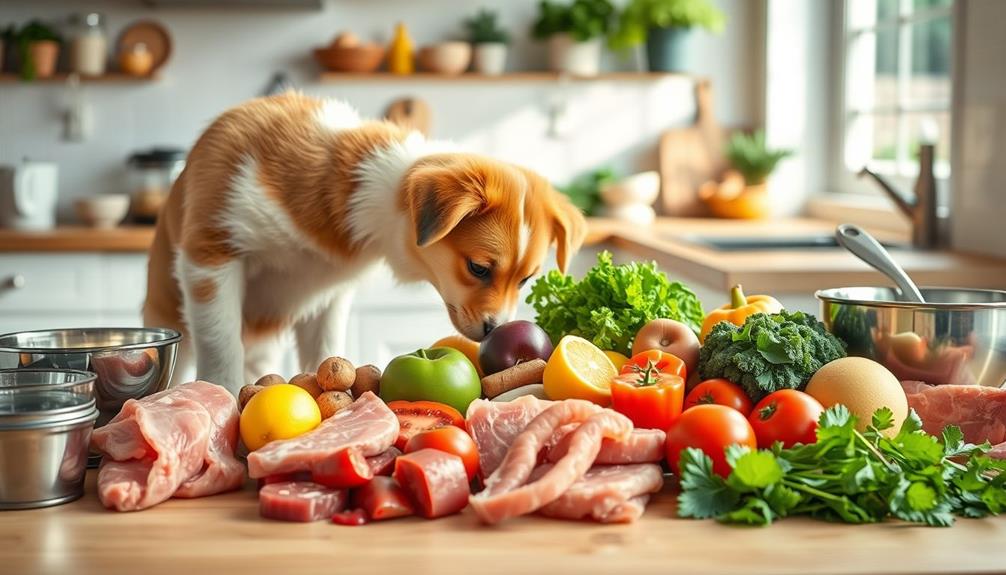Feeding your puppy the right amount of raw food is essential for their growth and health. Generally, you should start by offering 8-10% of their current weight if they're 2-4 months old, tapering to 2-4% by 8-12 months. Feed them 3-4 times daily initially, then reduce to 2-3 meals as they mature. Always adjust portions based on your puppy's activity level and weight checks. Shift slowly to avoid digestive issues, and choose high-quality ingredients. Keeping an eye on your puppy's stool and energy levels will guide you. Stick around to discover more tips for a successful raw feeding journey! When it comes to feeding your puppy a raw diet, it’s important to source high-quality ingredients from reputable suppliers. You can find a variety of options from online raw dog food suppliers, offering a range of proteins and nutrient-dense options to support your puppy’s development. Researching and choosing the right supplier for your puppy’s raw food needs is crucial for their long-term health and well-being.
Key Takeaways
- Puppies aged 2-4 months require 8-10% of their current weight in raw food daily, tapering to 2-4% by 8-12 months.
- A balanced BARF diet should consist of 58% muscle meat, 17% raw edible bone, and 25% organs and vegetables.
- Establish a structured feeding schedule with 3-4 meals per day until 16 weeks, then reduce to 2-3 meals until 12 months.
- Monitor your puppy's weight weekly to ensure proper growth and adjust food portions based on activity levels and stool consistency.
- Gradually transition to a raw diet over 7-10 days, starting with small portions and a single protein source to avoid digestive issues.
Understanding Puppy Nutritional Needs
Understanding your puppy's nutritional needs is vital for their growth and development. Puppies have specific requirements that change as they age, and meeting these requirements is essential for their overall health. A balanced diet provides the necessary nutrients they need, including high-quality proteins, fats, carbohydrates, vitamins, and minerals.
For ideal puppy feeding, you should aim for a diet consisting of about 5-6% of their growing body weight in food; younger puppies may need even higher percentages to support rapid growth. Additionally, being mindful of their budget for puppy care can help guarantee you can consistently provide high-quality food.
The recommended BARF diet for puppies includes around 58% muscle meat, 17% raw edible bone, 7% vegetables, 7% liver, and 7% other secreting organs. This combination guarantees they receive the extensive nutrition necessary to meet their nutritional requirements.
As your puppy grows, adjust their food intake according to their weight. For those aged 2-4 months, aim for 8-10% of their current weight, decreasing to 2-4% by 8-12 months.
Regularly monitoring growth rates through weekly weight checks will help guarantee your puppy is on track for healthy development. By staying attentive to their nutritional needs, you'll set the foundation for a strong, healthy adult dog.
Daily Raw Food Requirements
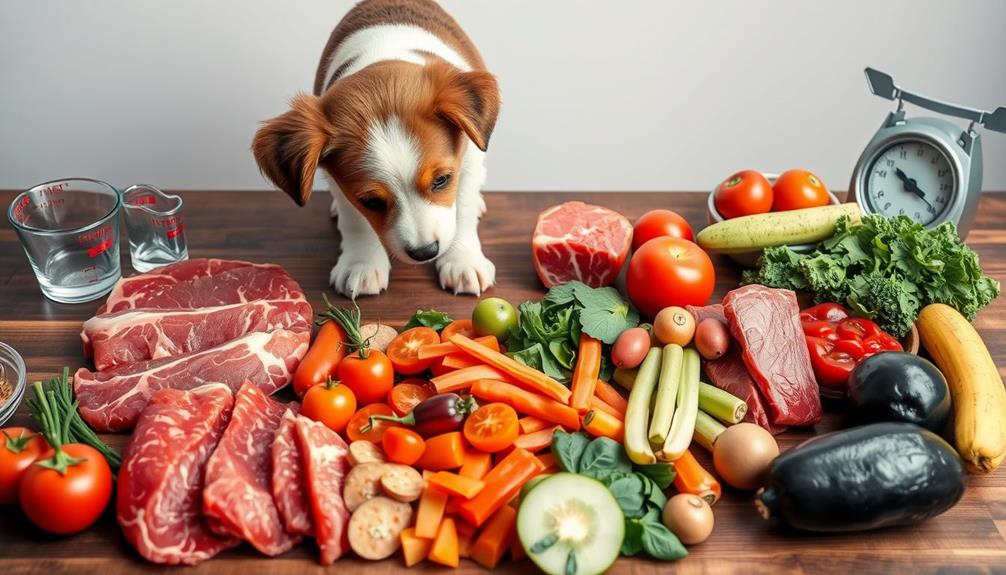
To guarantee your puppy gets the right amount of raw food, start by determining their ideal body weight.
It's important to provide a balanced diet that includes proteins, vitamins, and minerals to support their growth, just like the proper diet for hamsters.
Follow age-specific feeding guidelines to adjust portions as they grow, and keep a close eye on their growth progression.
Regular monitoring will help you fine-tune their diet for healthy development.
Determine Ideal Body Weight
Determining your puppy's ideal body weight is essential for establishing their daily raw food requirements. To do this, consider their breed and expected adult size, as these factors influence the feeding amounts.
Generally, puppies need about 8-10% of their current weight in puppy food from 2-4 months, tapering to 2-4% by 8-12 months. It's also important to account for any specific health considerations, such as financial considerations for elderly care that might impact your overall budget for pet care.
Regularly monitor your puppy's weight to guarantee they maintain a healthy body condition, aiming for a visible waist and rib visibility. Using a feeding calculator can help you accurately determine daily raw food requirements based on your puppy's age, weight, and activity level.
Keep in mind that active puppies may require a higher percentage of their weight in food compared to less active ones. Adjust feeding amounts as needed, especially if you notice rapid growth or changes in activity levels.
Age-Specific Feeding Guidelines
Feeding your puppy the right amount of raw food is vital at each stage of their growth, as their nutritional needs change rapidly. For puppies aged 2-4 months, you should provide 8%-10% of their current weight in raw food daily to support their rapid growth and energy needs.
This period is also key for establishing healthy habits and guaranteeing proper emotional and psychological growth, as key domains of development indicate that early nutrition can greatly impact overall well-being.
As they reach 4-6 months, this requirement decreases to 6%-8% of their current weight, reflecting a slight slowdown in their growth rate.
From 6-8 months, aim for 4%-6% of their current weight in raw food daily. This amount continues to support their development without promoting excessive calorie intake.
Once your puppy is between 8-12 months, you should feed them 2%-4% of their current weight in raw food daily, helping them shift toward adulthood.
It's important to adjust these feeding amounts based on your puppy's activity level. Active puppies may require a higher percentage of raw food compared to their less active counterparts.
Always monitor their weight and adjust feeding accordingly to guarantee they're growing healthy and strong.
Monitor Growth Progression
Monitoring your puppy's growth is essential for ensuring they get the right amount of raw food as they develop. As a responsible pet owner, you should regularly assess their weight and adjust their food intake accordingly. This helps maintain their ideal weight and promotes healthy growth.
Here's a quick reference for daily raw food requirements based on your puppy's age:
| Age Range (Months) | % of Body Weight to Feed |
|---|---|
| 2-4 | 8-10% |
| 4-6 | 6-8% |
| 6-8 | 4-6% |
| 8-12 | 2-4% of ideal weight |
Feeding Schedule and Frequency
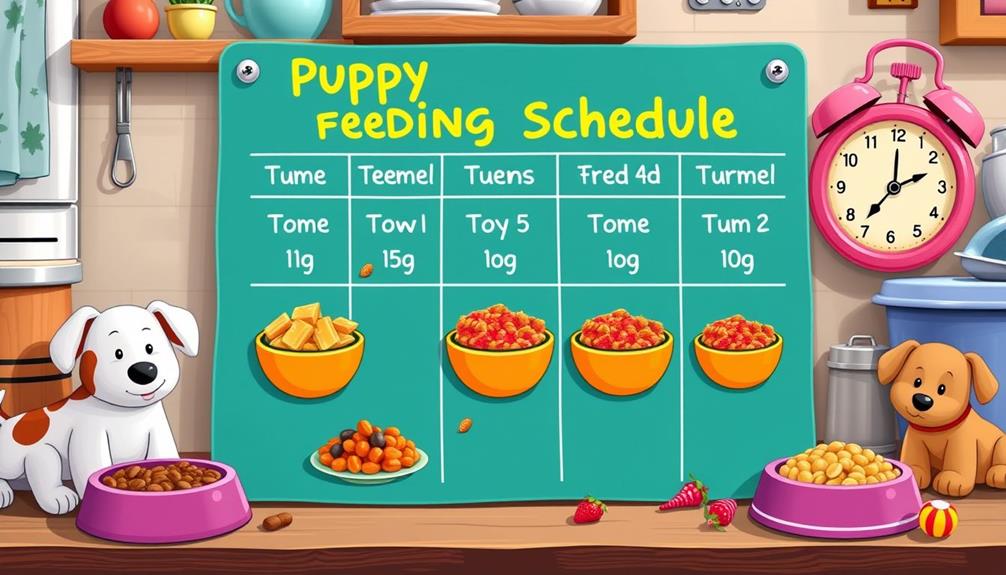
Typically, puppies thrive on a structured feeding schedule that accommodates their rapid growth and high energy levels. For the first 16 weeks, feed your puppy a raw diet with 3-4 meals per day. This frequent feeding helps meet their nutritional needs, and it's important to keep in mind possible cold medications overview if your puppy experiences any respiratory issues.
As they grow, you can reduce the meals to 2-3 per day until they reach 12 months of age.
Here are some key points to reflect on when establishing your puppy's feeding schedule:
- Daily Food Requirement: For puppies aged 2-4 months, feed about 8-10% of their current weight, decreasing to 4-6% by 6-8 months.
- Monitor Weight: Regularly monitor your puppy's weight weekly to adjust feeding amounts based on their growth and activity level.
- Use Feeding Charts: Utilize feeding charts to determine precise food amounts according to your puppy's age and weight, ensuring they receive proper nutrition.
Customizing the feeding schedule based on your puppy's breed, size, and lifestyle is vital for best health and development. By following these guidelines, you'll help your puppy grow strong and healthy.
Transitioning to Raw Diet
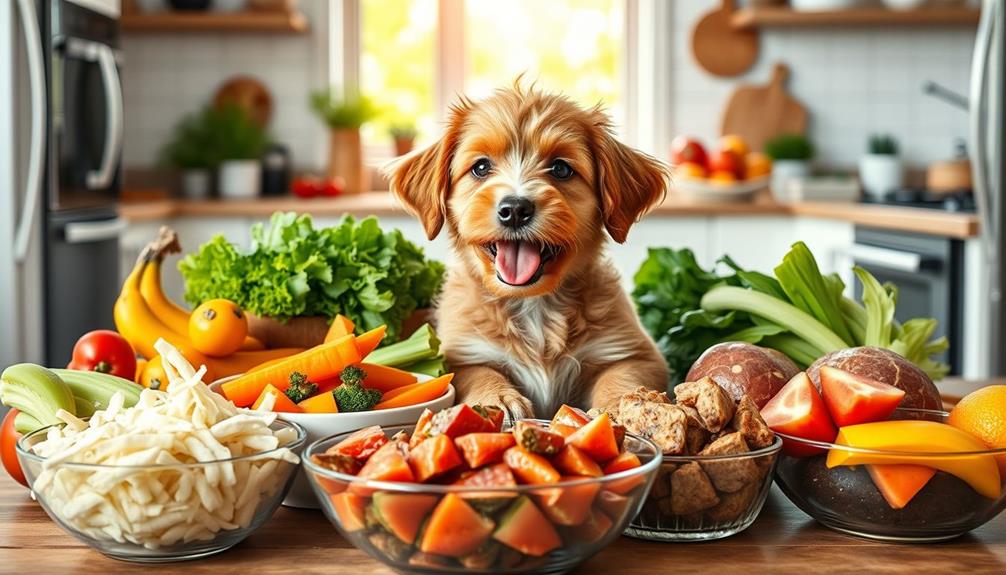
When shifting your puppy to a raw diet, it's important to do it gradually over 7-10 days.
Start with small portions and keep an eye on their digestive health to guarantee they're adjusting well.
Incorporating gentle adjustments, much like how one would sleep better by easing into new routines, can help your puppy adapt.
If you notice any issues, you may need to adjust the food portions or the types of proteins you're introducing.
Gradual Transition Process
Shifting your puppy to a raw diet requires a careful, gradual approach to confirm their digestive system adjusts properly. The gradual change process is essential for preventing digestive upset, much like how a juice diet must be monitored for individual tolerance.
Over 7-10 days, start introducing small portions of raw food, focusing on a single protein source initially. This way, you can monitor for any adverse reactions.
During this change, keep these tips in mind:
- Adjust portion sizes based on your puppy's tolerance and comfort.
- Avoid mixing raw food with kibble, as it can complicate digestion for puppies.
- Consult with a veterinarian for personalized guidance and to confirm the diet meets your puppy's specific nutritional needs.
As you progress, observe how your puppy responds and make necessary adjustments. If they seem comfortable and happy, you can gradually increase the amount of raw food while remaining attentive to their reactions.
This careful approach not only supports a successful change but also sets the foundation for a healthy diet. Remember, your puppy's well-being is the priority!
Monitoring Digestive Health
Monitoring your puppy's digestive health during the change to a raw diet is essential for guaranteeing their well-being. As you introduce raw food, keep a close eye on your puppy's stool consistency. Firm and well-formed stools indicate a healthy adjustment, while diarrhea or overly soft stools may suggest digestive upset.
Start the shift gradually over 7-10 days, offering small portions to assess your puppy's tolerance and response. Incorporating healthy dog snacks during this change can also help maintain interest in their diet while providing essential nutrients.
In addition to stool consistency, pay attention to your puppy's energy levels and overall behavior. A decrease in energy or signs of discomfort can signal issues with the new diet. Regularly check their weight and body condition; a visible waist and ribs that feel like the back of your hand are indicators of proper weight management.
If you notice any persistent digestive issues, don't hesitate to consult with a veterinarian for personalized guidance. They can help you make necessary adjustments to guarantee your puppy thrives on their new raw food diet.
Adjusting Food Portions
Adjusting food portions is important for ensuring your puppy thrives on a raw diet. Start by gradually introducing raw food over 7-10 days, using small portions to assess your puppy's tolerance.
For puppies aged 2-4 months, calculate feeding amounts at 8-10% of their current weight. As they grow, adjust the feeding percentage to support healthy growth:
- 4-6 months: Decrease to 6-8%
- 6-8 months: Decrease to 4-6%
- 8-12 months: Decrease to 2-4%
In addition, keeping an eye on your puppy's overall health can be advantageous; incorporating essential oils for respiratory health may help maintain their liveliness.
Always monitor your puppy's weight and health by checking for a visible waist and rib visibility. If you notice any changes, be ready to adjust their portions.
Stool consistency is another significant indicator of dietary balance; if stools are too loose or too firm, consider modifying feeding amounts.
Monitoring Growth and Health
Keeping an eye on your puppy's growth and health is crucial to guaranteeing they're thriving on a raw food diet. Start by regularly weighing your puppy each week. This helps you monitor their weight and guarantees they're growing at a healthy rate. Adjust their food portions as necessary based on their age and size.
Additionally, incorporating a balanced diet rich in essential nutrients is key for supporting your puppy's overall health and development, as effective strategies for weight loss can also apply to young pets.
Next, pay attention to your puppy's stool consistency. Firm, well-formed stools indicate a balanced diet, while loose stools may suggest overfeeding or dietary imbalances. Additionally, check your puppy's body condition; you should be able to feel their ribs without them protruding, indicating they're at an ideal weight.
Don't forget to track your puppy's energy levels and overall activity. A lack of energy might signal insufficient nutrition or health issues that need addressing.
Regular consultations with a veterinarian are also crucial. They'll help you assess your puppy's growth and adjust their raw food diet according to their individual needs and developmental stages.
Benefits of Raw Feeding
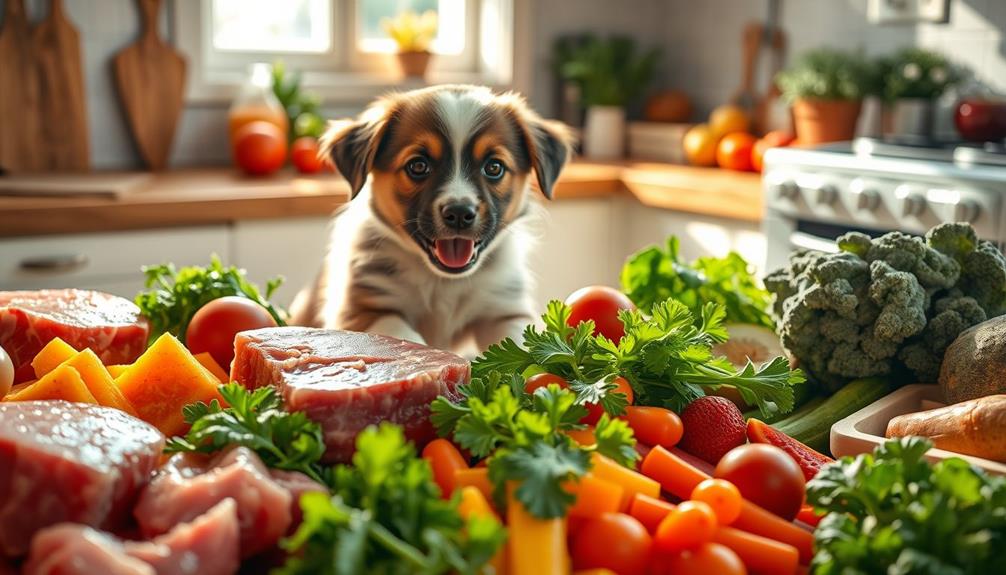
As you focus on your puppy's growth and health, it's important to recognize the numerous benefits that a raw feeding regimen can offer. By opting for a raw diet, you're providing your puppy with a nutrient-dense source of food that supports various aspects of their well-being.
Here are some key benefits of raw feeding:
- Improved digestion: Raw diets enhance nutrient absorption, promoting better gut health.
- Stronger immune systems: Essential nutrients found in raw food help boost your puppy's defense against illnesses.
- Higher energy levels: Puppies on a raw diet typically experience balanced energy throughout the day, supporting their active lifestyle.
Additionally, feeding your puppy raw can lead to better skin and coat conditions, thanks to high-quality fats.
Natural chewing on raw bones not only keeps them entertained but also contributes to healthier gums and reduced plaque buildup.
Ultimately, the benefits of raw feeding can enhance your puppy's vitality and longevity, ensuring they grow into a healthy, active adult dog.
Embracing this natural approach to their diet is a proactive step towards their overall health and happiness.
Choosing Quality Raw Food
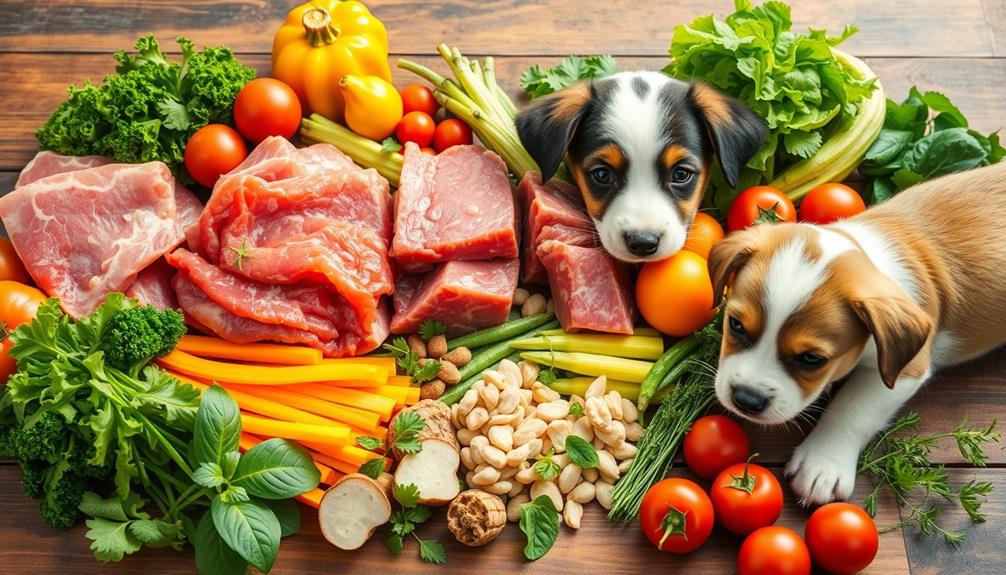
Selecting the right raw food for your puppy is critical for their development and overall health. When you're choosing puppies raw food, make certain it meets AAFCO Nutrient Profiles for Growth and Development. This guarantees balanced nutrition essential for their rapid growth.
Look for quality raw food that features a high percentage of muscle meat, ideally around 58%, along with raw edible bone making up about 17%. This combination guarantees your puppy gets adequate protein and calcium levels.
Incorporate a variety of fresh ingredients, like vegetables and fruits, to boost nutrient diversity and provide important nutrients, vitamins, and antioxidants. It's also important to opt for reputable brands that prioritize high-quality ingredients and adhere to strict safety protocols. This minimizes the risk of bacterial contamination, which can be harmful to your puppy.
Lastly, consider the specific dietary needs of your puppy's breed and size. Some formulations are specially designed for large breed puppies, helping to prevent growth-related health issues.
Potential Risks of Raw Diet

Feeding your puppy a raw diet can come with significant risks that every owner should be aware of. While some pet owners swear by the benefits, it's important to understand the potential downsides.
- Bacterial contamination: Raw meat can harbor harmful bacteria like Salmonella and E. coli, which can affect both your puppy and anyone handling the food.
- Nutritional deficiencies: If the raw diet isn't properly balanced, your puppy may suffer from nutritional deficiencies, particularly in calcium and phosphorus, which are essential for bone health and growth.
- Digestive upset: Shifting to a raw diet can cause digestive upset in some puppies, requiring careful monitoring and a gradual introduction of new foods.
To minimize these risks, always source high-quality ingredients and practice safe handling techniques.
Proper hygiene and food storage are key to reducing the chances of bacterial contamination.
Community Support and Resources
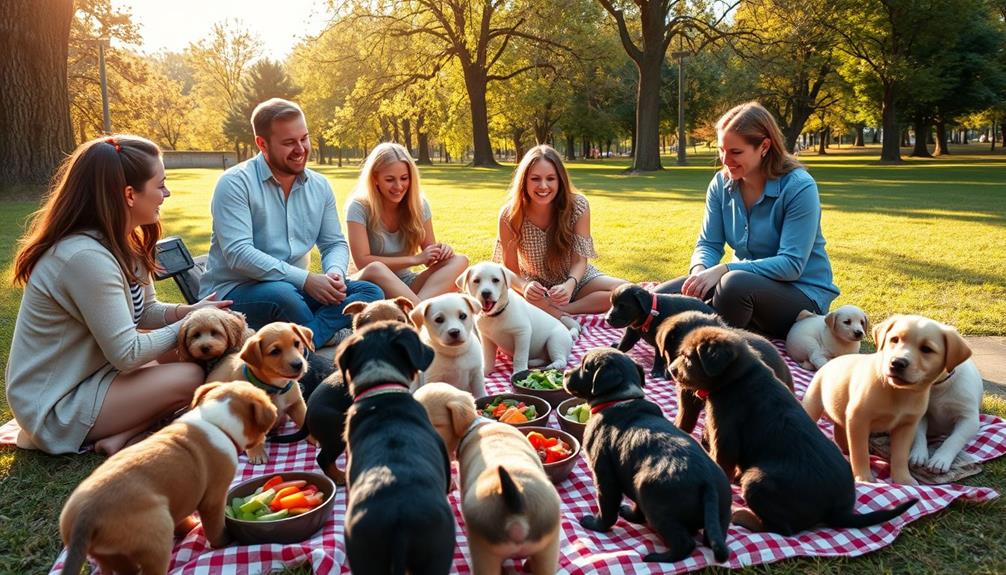
Steering through the world of raw feeding for your puppy can be overwhelming, but you're not alone. You can tap into a wealth of community support to make the journey smoother. Online platforms like The Pack connect you with fellow pet lovers who share experiences and offer advice on raw feeding practices.
Social media groups dedicated to raw feeding also provide access to expert guidance on puppy care and nutrition. Here, you can engage in discussions, ask questions, and get valuable insights from seasoned raw feeders.
Additionally, you'll find numerous nutrition resources, including feeding charts and adjustment guides, designed to help you navigate your puppy's raw diet effectively.
If you're concerned about sourcing quality ingredients, local stockist finders can help you locate nearby suppliers of raw puppy food. Plus, many subscription services offer community support and expert resources, enhancing your raw feeding experience with tailored advice and discounts.
Embracing these resources can empower you to make informed decisions, ensuring your puppy thrives on a balanced raw diet.
Frequently Asked Questions
How Much Raw Food Should I Feed My Puppy?
You should feed your puppy about 8-10% of their body weight in raw food when they're young, then gradually decrease to 2-4% as they grow. Monitor their weight to adjust portions accordingly.
What Is the 80 10 10 Rule for Raw Dog Food?
Think of the 80/10/10 rule as a balanced meal plate for your puppy. It means 80% muscle meat, 10% raw bones, and 10% organ meat, ensuring your furry friend gets all essential nutrients.
What Are the Guidelines for Raw Feeding Puppies?
When raw feeding puppies, start with 8-10% of their body weight, adjust to 2-4% as they grow. Guarantee a balanced diet, monitor weight, and feed three times daily until six months old.
How to Calculate How Much Raw Food to Feed a Dog?
To calculate how much raw food to feed your dog, start with their ideal weight. Use 2-4% of that weight for adults, adjusting for activity level, and monitor their growth and stool consistency regularly.
Conclusion
In summary, feeding your puppy a raw diet can be rewarding, but it's essential to do it right. Did you know that puppies on a balanced raw diet can experience up to a 30% increase in energy levels? By ensuring you meet their nutritional needs and shifting properly, you can support their growth and health. Remember, quality matters, so choose the best raw food, and don't hesitate to reach out for community support as you start this journey.

